Home Page
|
Topics: |
After logging into the application, you are redirected to the Home page (Domain Main page), as shown in the following image.

The Home page contains the following areas:
- OGC menu.
- Domain drop-down list that allows you to select a required domain to work with.
- Advanced Search button to open the Search dialog.
- Breadcrumb trail, which allows you to keep track of your navigation within the application. You can click on a breadcrumb item to be redirected to this previously visited page.
- Grid with Golden records.
The default state of the Home page can be configured to display a list of domain records or without displaying a list of domain records. For more information, see Using the Administration Console.
If the default state of the Home page is configured not to display a list of domain records, then the Home page appears, as shown in the following image.

If the records are not displayed by default, then you can perform a search to generate a table, which displays relevant information that satisfy search criteria, as shown in the following image.

Note: When records are not displayed by default, the state of the page after a search has been performed is saved when navigating anywhere in the application.
The second default state of the Home page is to display a list of the records for a selected Domain in the system. The list of Domains and default current Domain are metadata driven and can be configured using the Administration Console. For more information, see Using the Administration Console.
Currently, OGC provides only one Domain called Party. The first 20 records are retrieved from the database and displayed. You can choose a number of records to be displayed per page and navigate to the next pages to view other records. For more information, see Using the Administration Console.
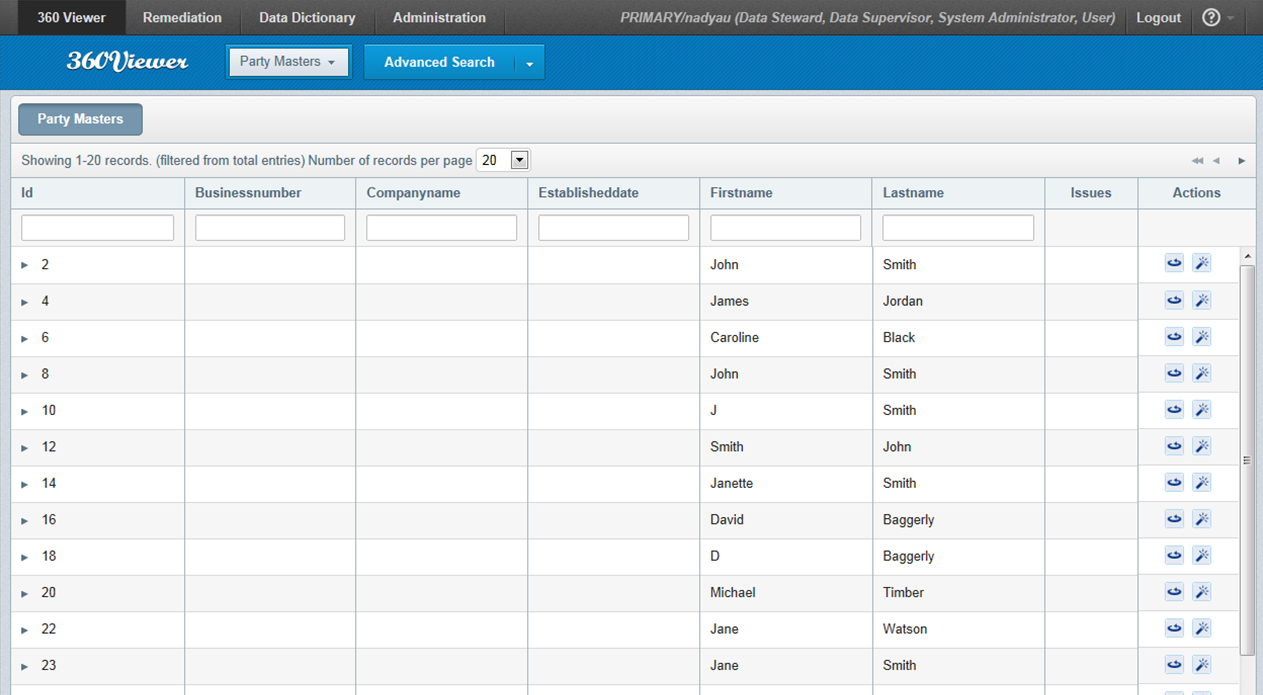
There are several types of tables in the 360 Viewer. All tables have a similar user interface, as shown in the following image.

In general, tables consist of:
- Page navigation
- Column headers
- Inputs for filtering
- List of records
Page navigation provides functionality to move to the next, previous, and first page (because the count of all records in the grid is unknown). The number of records per page selection specifies how many records can be shown on one page (available options 10, 15, 20 (default), 25, or 30).
You can also filter the results utilizing dynamic filters below the table column headers. The results are updated dynamically to show only relevant records while you specify the value (with some delay). Filtering can be applied to several columns at a time.
Note: Only filtering by exact values is supported. Wildcard search is currently not supported.
Data entered in filtration fields is validated before filtering starts. Validation is performed dynamically while you specify the value. When invalid data is entered, a validation message is displayed and the corresponding field is highlighted in red, as shown in the following image.
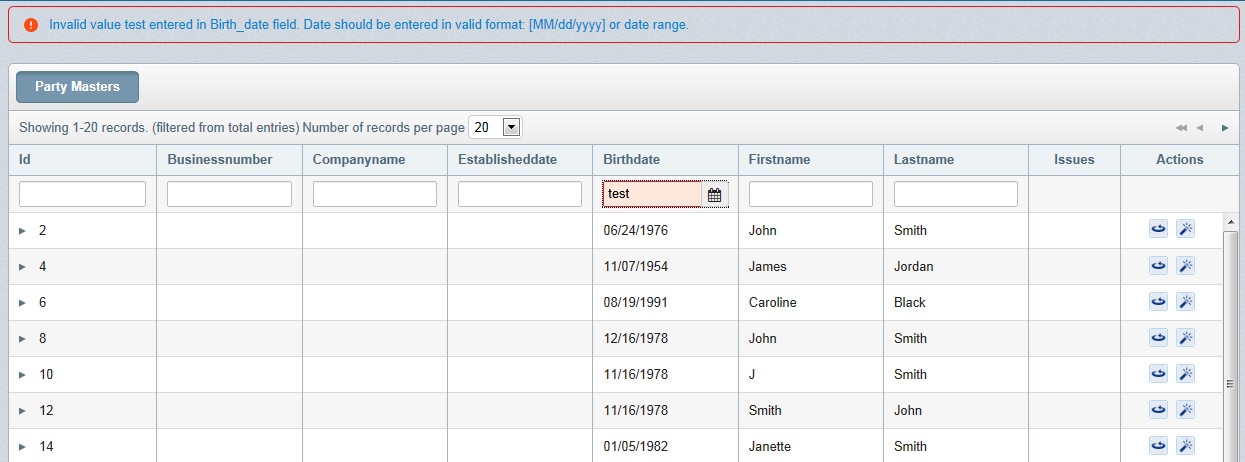
Validation is performed for numeric fields and fields with date format.
Note: Valid filtering criteria is saved for the table when you navigate anywhere in the application.
You can select the width, alignment of columns, what columns can be sorted and filtered. This can be configured using the Administration Console. For more information, see Using the Administration Console.
For convenience, hints with the Copy button were implemented in all tables throughout the application. Hints appear when hovering the pointer over any value. When the Copy button is clicked, the value is copied and can be pasted in any input field, such as search or filtering fields.
Note: By default, hints with the Copy button are not available.
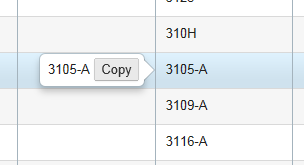
In the event that hints with a Copy button are not required, you can change these to ordinary browser hints using the Administration Console. For more information, see Using the Administration Console.
You can obtain a preview of a record. Note that the columns which are displayed are configurable by a system administrator. For more information, see Using the Administration Console.
The Preview Panel is displayed when you click anywhere on the record row. The row is highlighted upon hovering to indicate that the particular row can be selected. The Preview Panel is closed when you clicks the same record a second time or when another row is clicked on. However, only one preview panel may be opened at a time.
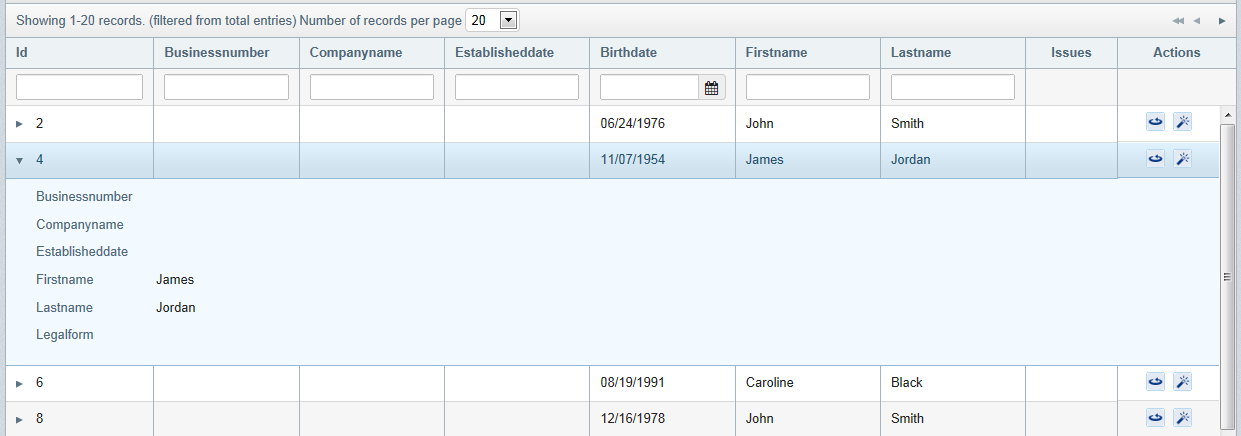
You can navigate to the Record 360 View by clicking Details 360 or view detailed Comparison View by clicking Master Comparison to see Golden Records and supporting Instance Records.
There are two possible ways of displaying Master Comparison and Details 360 links in the table:

The appearance of the Master Comparison and Details 360 links can be configured using the Administration Console. For more information, see Using the Administration Console.
Advanced Search Dialog (for Golden Records)
Your may need to enter more parameters to find the records. You can use the Advanced Search feature for this purpose. The Advanced Search is accessible by clicking the Advanced search button.

The Advanced search dialog consists of:
- Domain tabs. Allows you to change the domain for searching.
- Grouped attribute sections. Used for entering search parameters.
- Search, Clear, and Close buttons
Subdomain links allows you to search by subdomain record parameters. The list of displayed subdomains can be configured using the Administration Console. For more information, see Using the Administration Console.
Note: Currently, search by sub-domains is not supported.
The attributes in the Advanced Search dialog are grouped into sections to make it easier for you to find a required attribute. This can be configured using the Administration Console. For more information, see Using the Administration Console. Only one section can be expanded at a time: when another section header is clicked, the new section is opened and the previous opened one is closed.
Note: Filtering by exact values only is supported. Wildcard search is not supported.
Clicking Search launches the search and allows you to find certain attributes you wish.
Clicking Clear deletes all entered criteria.
Clicking Close hides the search overlay without launching the search or updating search results. The parameters you entered are cleared to the state they were on during the last performed Advanced Search.
If you have already received Advanced Search results and returned back to the search overlay to edit your search criteria, the values you entered in your previous query are preserved.
The validation mechanism for numeric fields and fields with date formats also work for domain and subdomain pages. When clicking Search after invalid data is entered, the appropriate validation message appears and the corresponding field is highlighted in red, as shown in the following image.

Some fields contain drop-down lists. In 360 Viewer, drop-down lists (data type Boolean) are supported only in the Advanced search dialog.

When clicking on a drop-down list, a list of possible values appear (for fields with Boolean type, there are two possible values Yes and No) and you can select the necessary option you wish.
Search Results Page
After performing a search on existing criteria, the resulting number of rows is displayed in the results table and search criteria.
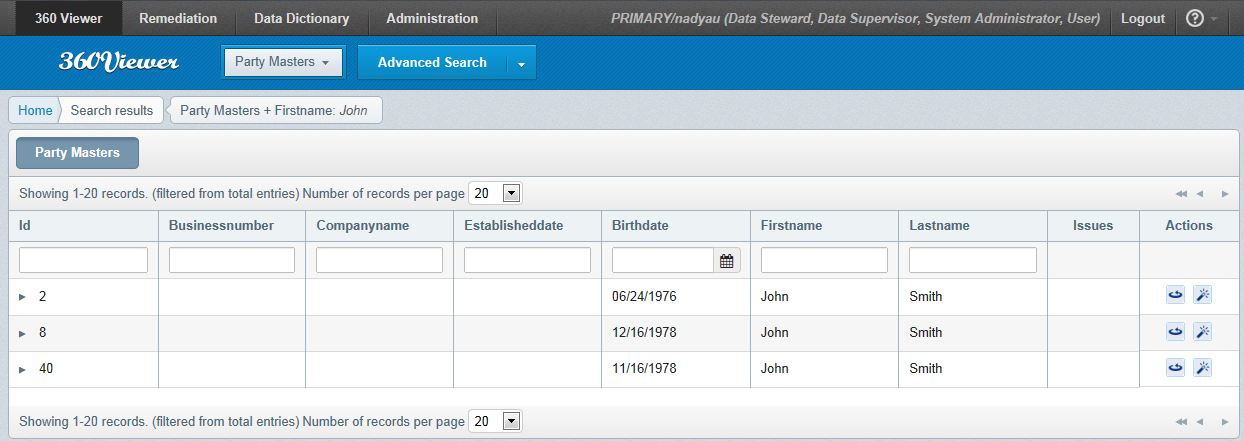
You can navigate to the Record 360 View from the search results page by clicking Details 360 or view detailed Comparison View by clicking Master Comparison to see the Golden Records and supporting Instance Records.
When performing a search by non-existing criteria, the appropriate message is displayed on the Search results page, as shown in the following image.

You can use links for quick access to the Advanced Search domain and the sub-domain dialog to issue a search using different criteria.